Design of Peptidomimetic Functionalized Cholesterol Based Lipid Nanoparticles for Efficient Delivery of Therapeutic Nucleic Acids
Abstract
1. Introduction
2. Materials and Methods
2.1. Chemicals
2.2. Synthesis of Intermediate 1
2.3. Synthesis of Chorn3
2.4. Formulation of Chorn Lipid Nanoparticle
2.5. Electrophoresis Mobility Shift Assay
2.6. Measurements of Particle Size of Chorn3 Nanoparticles
2.7. Transmission Electron Microscopy (TEM)
2.8. Confocal Imaging
2.9. Cell Culture and Cytotoxicity Assay
2.10. Transfection Efficiency
2.11. Statistical Analysis
3. Results
3.1. Synthesis and Characterization of Chorn3 Lipid
3.2. Formulation and Physicochemical Characterization of Chorn3 LNP
3.3. Electrophoresis Mobility Shift Assay
3.4. Cytotoxicity Assay
3.5. Cellular Uptake Assay
3.6. Plasmid Transfection
3.7. siRNA Delivery Assay
3.8. Phenotype of Plk1 Knockdown by Chorn3 LNP Mediated siRNA Delivery
4. Discussion
5. Conclusions
Supplementary Materials
Author Contributions
Funding
Conflicts of Interest
References
- Fire, A.; Xu, S.; Montgomery, M.K.; Kostas, S.A.; Driver, S.E.; Mello, C.C. Potent and specific genetic interference by double-stranded RNA in Caenorhabditis elegans. Nature 1998, 391, 806–811. [Google Scholar] [CrossRef] [PubMed]
- Elbashir, S.M.; Harborth, J.; Lendeckel, W.; Yalcin, A.; Weber, K.; Tuschl, T. Duplexes of 21-nucleotide RNAs mediate RNA interference in cultured mammalian cells. Nature 2001, 411, 494–498. [Google Scholar] [CrossRef] [PubMed]
- Far, R.K.-K.; Sczakiel, G. The activity of siRNA in mammalian cells is related to structural target accessibility: A comparison with antisense oligonucleotides. Nucleic Acids Res. 2003, 31, 4417–4424. [Google Scholar] [CrossRef]
- Whitehead, K.A.; Dahlman, J.E.; Langer, R.S.; Anderson, D.G. Silencing or stimulation? siRNA delivery and the immune system. Annu. Rev. Chem. Biomol. Eng. 2011, 2, 77–96. [Google Scholar] [CrossRef] [PubMed]
- Aagaard, L.; Rossi, J.J. RNAi therapeutics: Principles, prospects and challenges. Adv. Drug Deliv. Rev. 2007, 59, 75–86. [Google Scholar] [CrossRef]
- Zhu, N.; Liggitt, D.; Liu, Y.; Debs, R. Systemic gene expression after intravenous DNA delivery into adult mice. Science 1993, 261, 209–211. [Google Scholar] [CrossRef] [PubMed]
- Caplen, N.J.; Alton, E.W.; Middleton, P.G.; Dorin, J.R.; Stevenson, B.J.; Gao, X.; Durham, S.R.; Jeffery, P.K.; Hodson, M.E.; Coutelle, C.; et al. Liposome-mediated CFTR gene transfer to the nasal epithelium of patients with cystic fibrosis. Nat. Med. 1995, 1, 39–46. [Google Scholar] [CrossRef]
- Chiu, Y.L.; Rana, T.M. siRNA function in RNAi: A chemical modification analysis. RNA 2003, 9, 1034–1048. [Google Scholar] [CrossRef]
- Morrissey, D.V.; Blanchard, K.; Shaw, L.; Jensen, K.; Lockridge, J.A.; Dickinson, B.; McSwiggen, J.A.; Vargeese, C.; Bowman, K.; Shaffer, C.S.; et al. Activity of stabilized short interfering RNA in a mouse model of hepatitis B virus replication. Hepatology 2005, 41, 1349–1356. [Google Scholar] [CrossRef]
- Morrissey, D.V.; Lockridge, J.A.; Shaw, L.; Blanchard, K.; Jensen, K.; Breen, W.; Hartsough, K.; Machemer, L.; Radka, S.; Jadhav, V.; et al. Potent and persistent in vivo anti-HBV activity of chemically modified siRNAs. Nat. Biotechnol. 2005, 23, 1002–1007. [Google Scholar] [CrossRef]
- Thi, E.P.; Mire, C.E.; Lee, A.C.; Geisbert, J.B.; Zhou, J.Z.; Agans, K.N.; Snead, N.M.; Deer, D.J.; Barnard, T.R.; Fenton, K.A.; et al. Lipid nanoparticle siRNA treatment of Ebola-virus-Makona-infected nonhuman primates. Nature 2015, 521, 362–365. [Google Scholar] [CrossRef] [PubMed]
- Heyes, J.; Palmer, L.; Bremner, K.; MacLachlan, I. Cationic lipid saturation influences intracellular delivery of encapsulated nucleic acids. J. Control. Release 2005, 107, 276–287. [Google Scholar] [CrossRef] [PubMed]
- Adams, D.; Gonzalez-Duarte, A.; O’Riordan, W.D.; Yang, C.C.; Ueda, M.; Kristen, A.V.; Tournev, I.; Schmidt, H.H.; Coelho, T.; Berk, J.L.; et al. Patisiran, an RNAi Therapeutic, for Hereditary Transthyretin Amyloidosis. N. Engl. J. Med. 2018, 379, 11–21. [Google Scholar] [CrossRef] [PubMed]
- Garber, K. Alnylam launches era of RNAi drugs. Nat. Biotechnol. 2018, 36, 777–778. [Google Scholar] [CrossRef] [PubMed]
- Soutschek, J.; Akinc, A.; Bramlage, B.; Charisse, K.; Constien, R.; Donoghue, M.; Elbashir, S.; Geick, A.; Hadwiger, P.; Harborth, J.; et al. Therapeutic silencing of an endogenous gene by systemic administration of modified siRNAs. Nature 2004, 432, 173–178. [Google Scholar] [CrossRef] [PubMed]
- Hattori, Y.; Machida, Y.; Honda, M.; Takeuchi, N.; Yoshiike, Y.; Ohno, H.; Onishi, H. Small interfering RNA delivery into the liver by cationic cholesterol derivative-based liposomes. J. Liposome Res. 2017, 27, 264–273. [Google Scholar] [CrossRef] [PubMed]
- Ghosh, Y.K.; Visweswariah, S.S.; Bhattacharya, S. Advantage of the ether linkage between the positive charge and the cholesteryl skeleton in cholesterol-based amphiphiles as vectors for gene delivery. Bioconjug. Chem. 2002, 13, 378–384. [Google Scholar] [CrossRef]
- Gao, X.; Huang, L. A novel cationic liposome reagent for efficient transfection of mammalian cells. Biochem. Biophys. Res. Commun. 1991, 179, 280–285. [Google Scholar] [CrossRef]
- Ju, J.; Huan, M.L.; Wan, N.; Qiu, H.; Zhou, S.Y.; Zhang, B.L. Novel cholesterol-based cationic lipids as transfecting agents of DNA for efficient gene delivery. Int. J. Mol. Sci. 2015, 16, 5666–5681. [Google Scholar] [CrossRef]
- Ghosh, A.; Mukherjee, K.; Jiang, X.; Zhou, Y.; McCarroll, J.; Qu, J.; Swain, P.M.; Baigude, H.; Rana, T.M. Design and assembly of new nonviral RNAi delivery agents by microwave-assisted quaternization (MAQ) of tertiary amines. Bioconjug. Chem. 2010, 21, 1581–1587. [Google Scholar] [CrossRef]
- Gerile, G.; Ganbold, T.; Li, Y.; Baigude, H. Head group configuration increases the biocompatibility of cationic lipids for nucleic acid delivery. J. Mater. Chem. B 2017, 5, 5597–5607. [Google Scholar] [CrossRef]
- Xiao, H.; Altangerel, A.; Gerile, G.; Wu, Y.; Baigude, H. Design of Highly Potent Lipid-Functionalized Peptidomimetics for Efficient in Vivo siRNA Delivery. ACS Appl. Mater. Interfaces 2016, 8, 7638–7645. [Google Scholar] [CrossRef] [PubMed]
- Chiu, Y.L.; Ali, A.; Chu, C.Y.; Cao, H.; Rana, T.M. Visualizing a correlation between siRNA localization, cellular uptake, and RNAi in living cells. Chem. Biol. 2004, 11, 1165–1175. [Google Scholar] [CrossRef] [PubMed]
- Simeoni, F.; Morris, M.C.; Heitz, F.; Divita, G. Insight into the mechanism of the peptide-based gene delivery system MPG: Implications for delivery of siRNA into mammalian cells. Nucleic Acids Res. 2003, 31, 2717–2724. [Google Scholar] [CrossRef] [PubMed]
- Eguchi, A.; Meade, B.R.; Chang, Y.C.; Fredrickson, C.T.; Willert, K.; Puri, N.; Dowdy, S.F. Efficient siRNA delivery into primary cells by a peptide transduction domain-dsRNA binding domain fusion protein. Nat. Biotechnol. 2009, 27, 567–571. [Google Scholar] [CrossRef] [PubMed]
- Bivalkar-Mehla, S.; Mehla, R.; Chauhan, A. Chimeric peptide-mediated siRNA transduction to inhibit HIV-1 infection. J. Drug Target. 2017, 25, 307–319. [Google Scholar] [CrossRef] [PubMed]
- McCarroll, J.A.; Dwarte, T.; Baigude, H.; Dang, J.; Yang, L.; Erlich, R.B.; Kimpton, K.; Teo, J.; Sagnella, S.M.; Akerfeldt, M.C.; et al. Therapeutic targeting of polo-like kinase 1 using RNA-interfering nanoparticles (iNOPs) for the treatment of non-small cell lung cancer. Oncotarget 2015, 6, 12020–12034. [Google Scholar] [CrossRef] [PubMed]
- Van Vugt, M.A.; Medema, R.H. Getting in and out of mitosis with Polo-like kinase-1. Oncogene 2005, 24, 2844–2859. [Google Scholar] [CrossRef] [PubMed]
- Strebhardt, K. Multifaceted polo-like kinases: Drug targets and antitargets for cancer therapy. Nat. Rev. Drug Discov. 2010, 9, 643–660. [Google Scholar] [CrossRef]
- Van der Meer, R.; Song, H.Y.; Park, S.H.; Abdulkadir, S.A.; Roh, M. RNAi screen identifies a synthetic lethal interaction between PIM1 overexpression and PLK1 inhibition. Clin. Cancer Res. Off. J. Am. Assoc. Cancer Res. 2014, 20, 3211–3221. [Google Scholar] [CrossRef]
- Ghosh, Y.K.; Visweswariah, S.S.; Bhattacharya, S. Nature of linkage between the cationic headgroup and cholesteryl skeleton controls gene transfection efficiency. FEBS Lett. 2000, 473, 341–344. [Google Scholar] [CrossRef]
- Cheng, X.; Lee, R.J. The role of helper lipids in lipid nanoparticles (LNPs) designed for oligonucleotide delivery. Adv. Drug Deliv. Rev. 2016, 99, 129–137. [Google Scholar] [CrossRef] [PubMed]
Sample Availability: Samples of the compounds are available from the authors. |
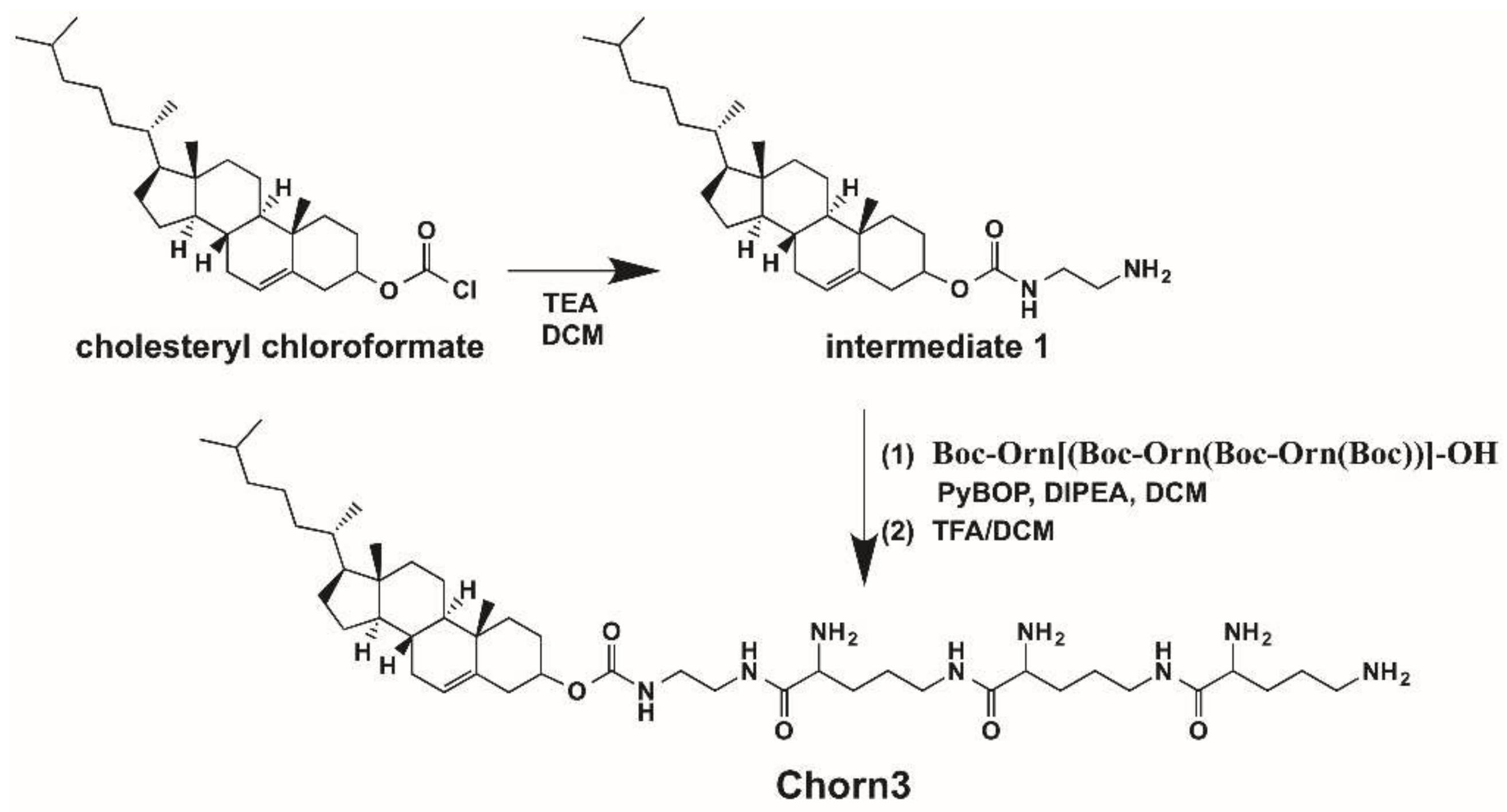
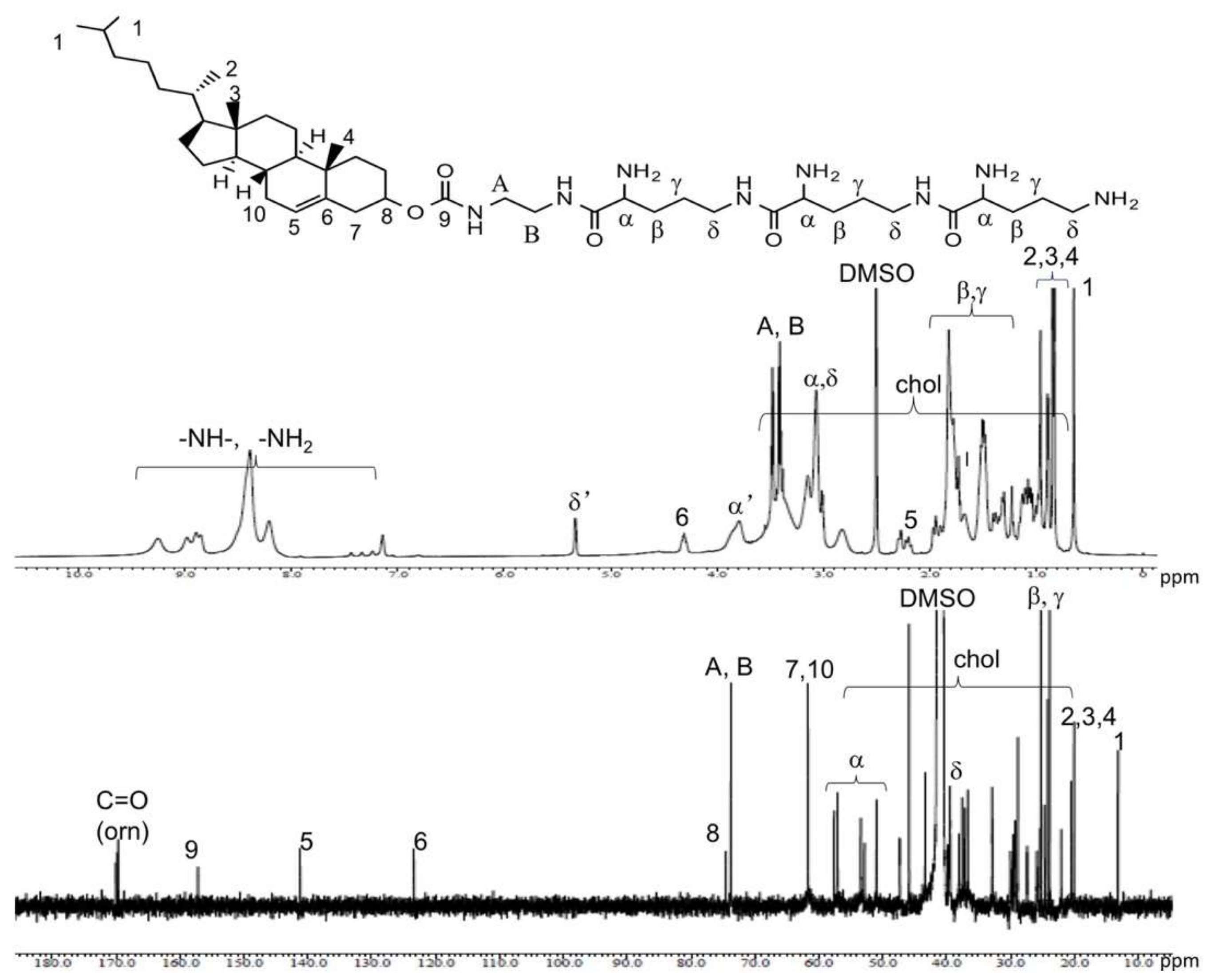
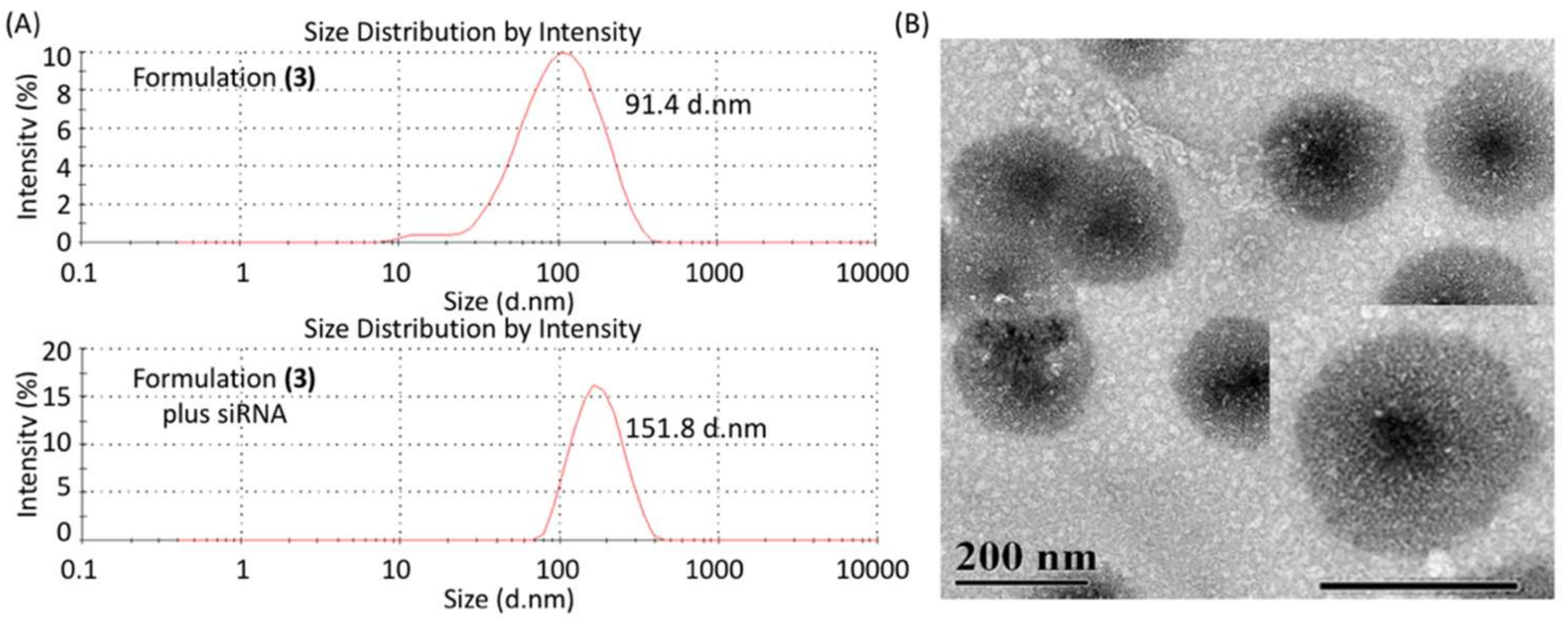
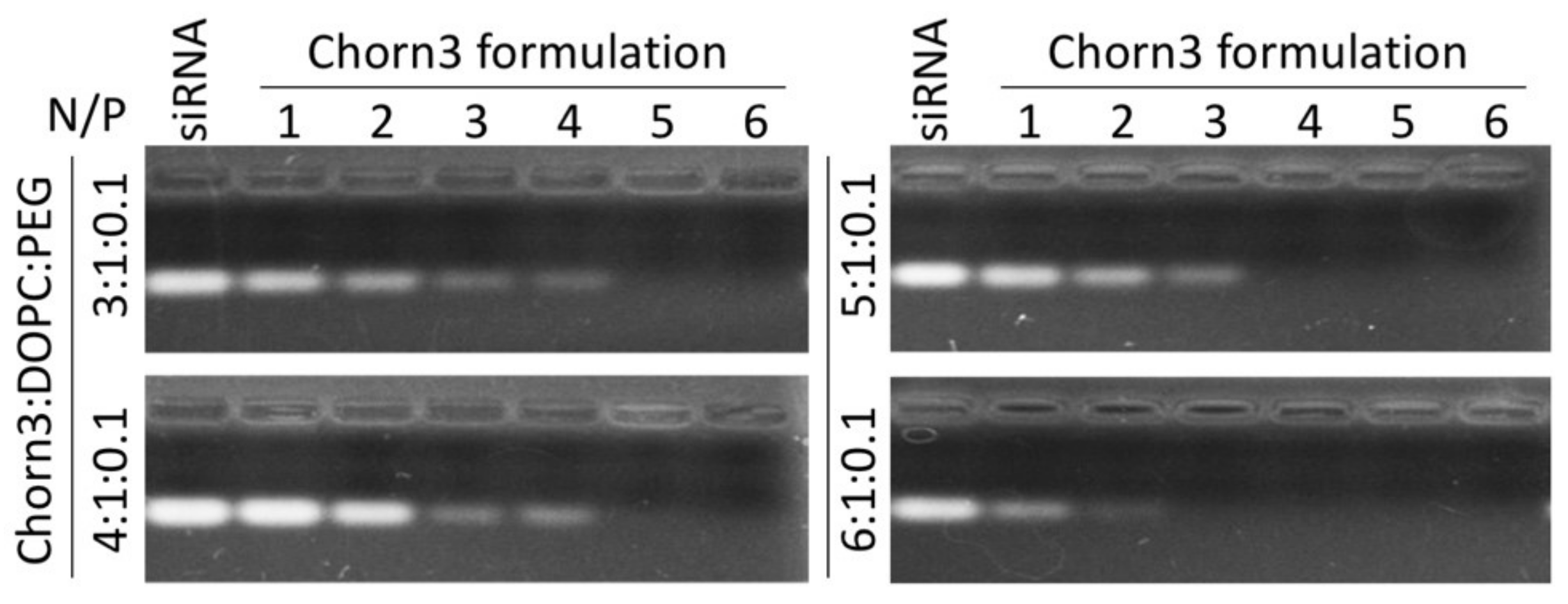

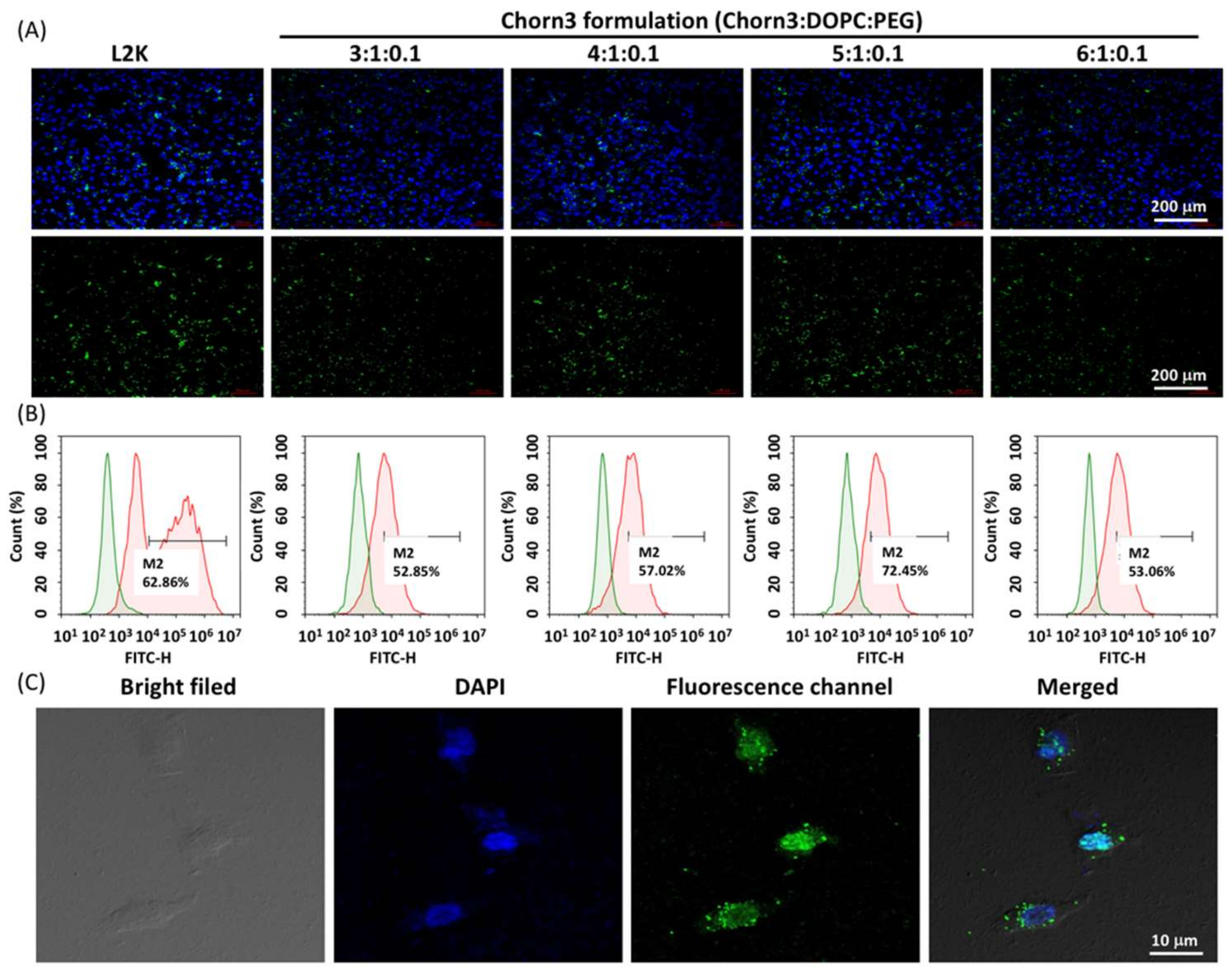
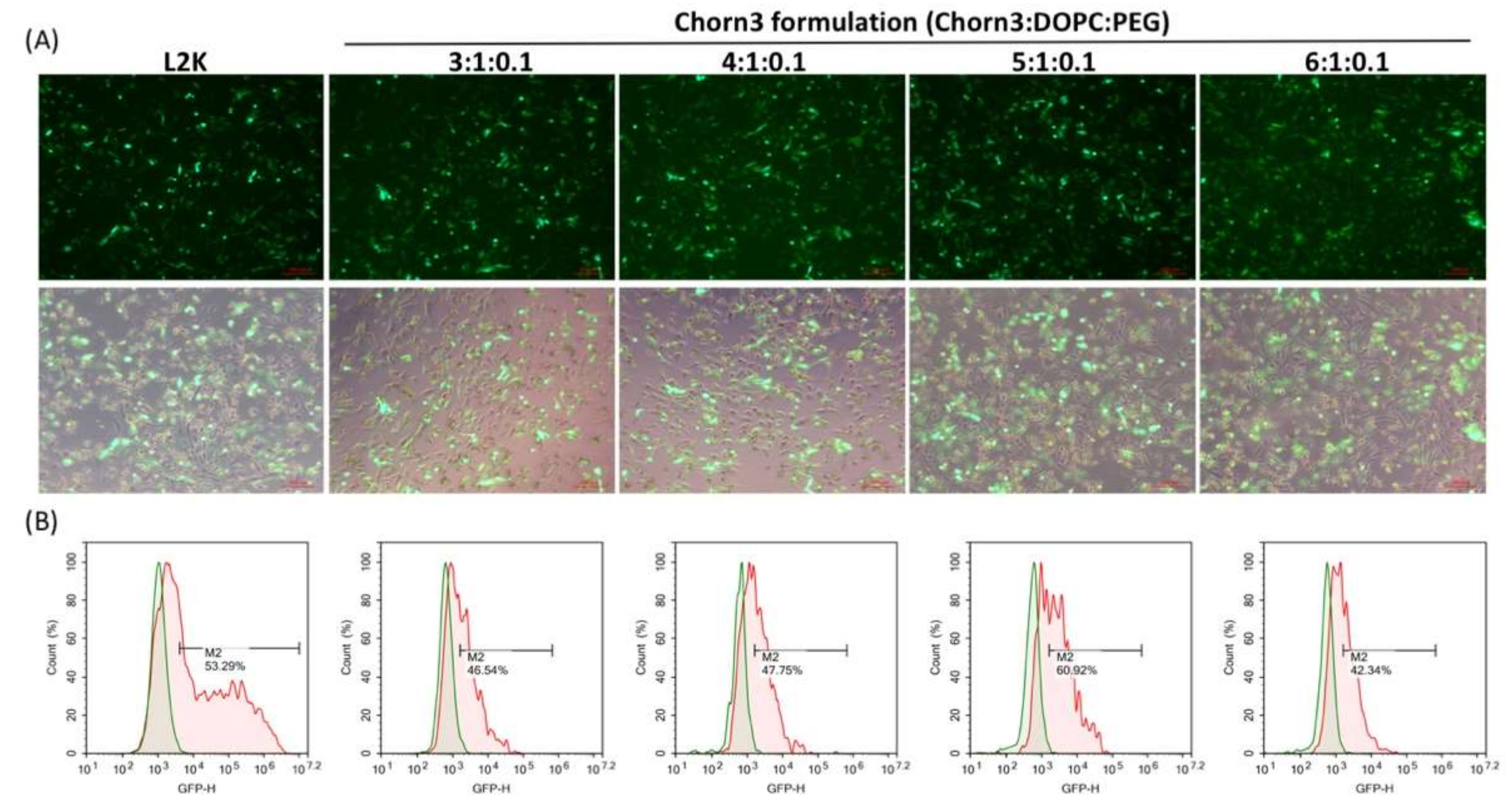

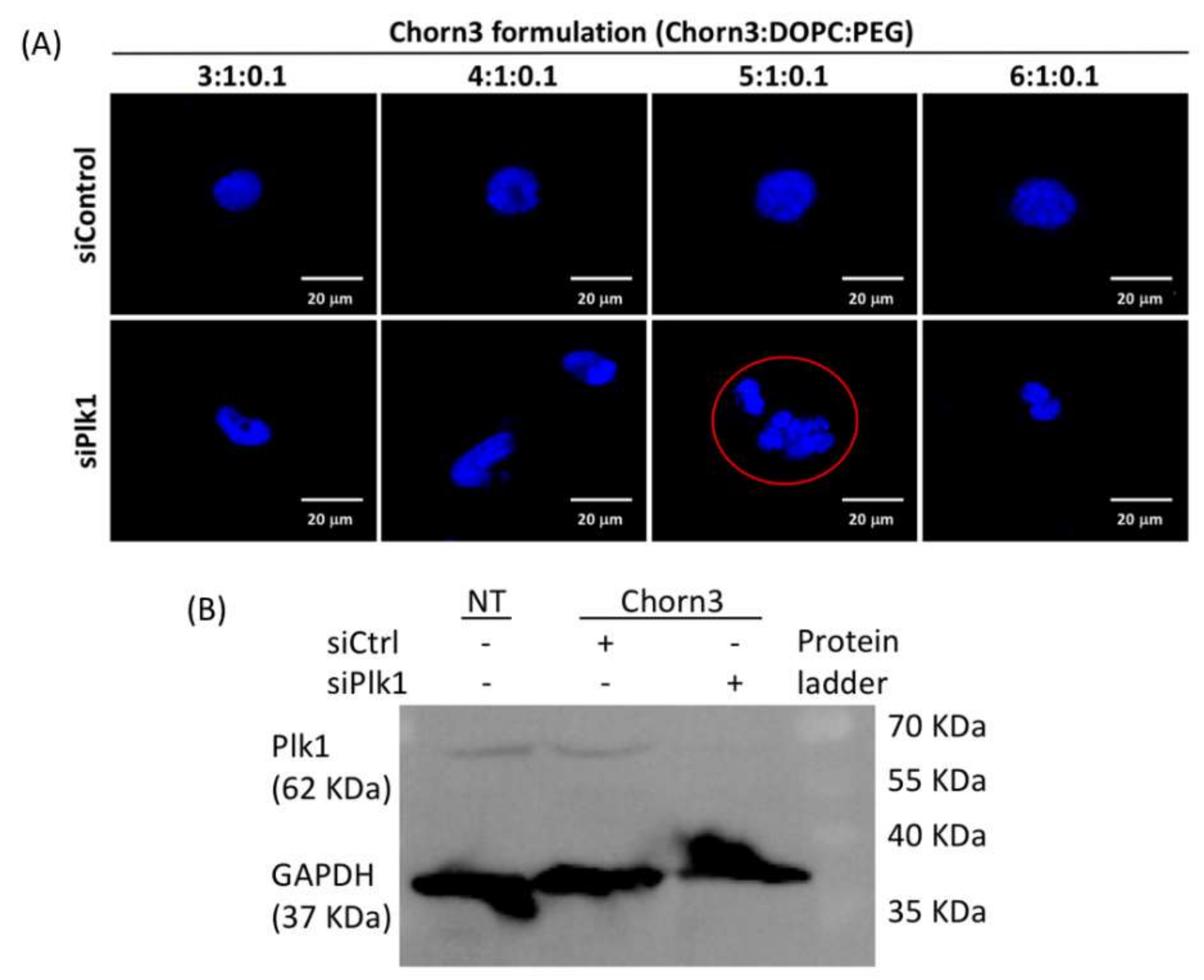
| Chorn3 Formulation | Stock Solution (μL) (a) | RNase Free Water (μL) (b) | Total Amine (N, nmol) | Stock siRNA (μL) (c) | Total Phosphate (P, nmol) | RNase Free H2O (μL) | N/P |
|---|---|---|---|---|---|---|---|
| 3:1:0.1 | 0.72 | 4.28 | 1.0 | 0.5 | 1.0 | 4.50 | 1.0 |
| 4:1:0.1 | 0.67 | 4.33 | 1.0 | ||||
| 5:1:0.1 | 0.64 | 4.36 | 1.0 | ||||
| 6:1:0.1 | 0.62 | 4.38 | 1.0 |
| Chorn3 Formulation No. | Ratio of Components (b) | Particle Size (d.nm) | Zeta Potential (mV) | ||
|---|---|---|---|---|---|
| −siRNA (PDI) | +siRNA (PDI) | −siRNA | +siRNA | ||
| (1) | 3:1:0.1 | 110.4 (0.27) | 178.4 (0.27) | 43.9 ± 3.2 | 27.2 ± 2.5 |
| (2) | 4:1:0.1 | 87.6 (0.24) | 167.4 (0.24) | 44.5 ± 3.5 | 28.9 ± 1.8 |
| (3) | 5:1:0.1 | 91.4 (0.24) | 151.8 (0.24) | 46.9 ± 2.1 | 33.2 ± 2.1 |
| (4) | 6:1:0.1 | 123.7 (0.25) | 197.8 (0.25) | 41.2 ± 2.5 | 26.2 ± 3.1 |
© 2019 by the authors. Licensee MDPI, Basel, Switzerland. This article is an open access article distributed under the terms and conditions of the Creative Commons Attribution (CC BY) license (http://creativecommons.org/licenses/by/4.0/).
Share and Cite
Ehexige, E.; Ganbold, T.; Yu, X.; Han, S.; Baigude, H. Design of Peptidomimetic Functionalized Cholesterol Based Lipid Nanoparticles for Efficient Delivery of Therapeutic Nucleic Acids. Molecules 2019, 24, 3413. https://doi.org/10.3390/molecules24183413
Ehexige E, Ganbold T, Yu X, Han S, Baigude H. Design of Peptidomimetic Functionalized Cholesterol Based Lipid Nanoparticles for Efficient Delivery of Therapeutic Nucleic Acids. Molecules. 2019; 24(18):3413. https://doi.org/10.3390/molecules24183413
Chicago/Turabian StyleEhexige, Ehexige, Tsogzolmaa Ganbold, Xiang Yu, Shuqin Han, and Huricha Baigude. 2019. "Design of Peptidomimetic Functionalized Cholesterol Based Lipid Nanoparticles for Efficient Delivery of Therapeutic Nucleic Acids" Molecules 24, no. 18: 3413. https://doi.org/10.3390/molecules24183413
APA StyleEhexige, E., Ganbold, T., Yu, X., Han, S., & Baigude, H. (2019). Design of Peptidomimetic Functionalized Cholesterol Based Lipid Nanoparticles for Efficient Delivery of Therapeutic Nucleic Acids. Molecules, 24(18), 3413. https://doi.org/10.3390/molecules24183413




